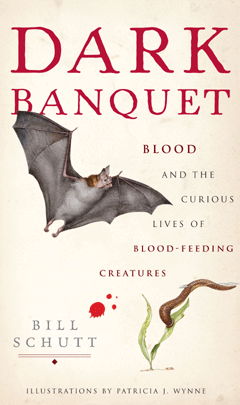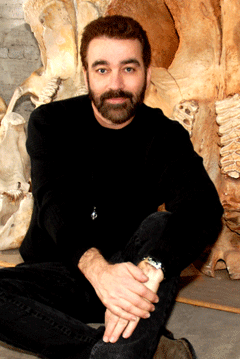The Blood Feeders
Air Date: Week of October 24, 2008

(Illustration: Patricia J. Wynne)
The gory habits of sanguivores don't just belong to vampire bats; birds, fish, bugs, and worms consume blood to survive, too. Are we missing out on gourmet cuisine? Bill Schutt, author of "Dark Banquet" talks with host Bruce Gellerman about blood and the creatures who love it.
Transcript
[SCARY MUSIC: Dracula, Universal Pictures]
GELLERMAN: It’s that time of year again… Bat time. When bats inspire and scare many a trick-or-treater.
[SCREAM]
GELLERMAN: Bats have also inspired many a B-movie: B, as in Bela.
LUGOSI: This is very old wine. I hope you will like it.
MAN: Aren’t you drinking?
LUGOSI: I never drink - wine.
GELLERMAN: You know what he drinks. And he’s not the only one with a fetish for the vital fluid.
Turns out there are over a thousand species that drink - blood. Collectively, they’re known as sanguivores, and Bill Schutt chronicles their gruesome ways in his new book “Dark Banquet: Blood and the Curious Lives of Blood-Feeding Creatures.” Bill Schutt is an associate professor of biology at Long Island University, and Professor, welcome to Living on Earth. Or should I say “I bid you velcome”!
SCHUTT: [LAUGHS] It’s great to be here, thanks for having me on.
GELLERMAN: Out of all the creepy animals you write about, I think the creepiest is the Candiru. Have I pronounced that correctly?
SCHUTT: Yeah, the vampire catfish. These are creatures that primarily feed underneath the gill covers of many large species of fish. They’re about maybe the size of a pencil, sort of shaped the same way. They wiggle their way underneath the gill cover, and they’ve got these things called odontodes, little spiky tooth-like structures all over their heads. And they just sort of clamp on with their jaws, shake their heads and the blood that then is released into the water is what they feed on, and they use their jaws to pump that blood down into their digestive track. But the problem is there have been several occurrences where these creatures have taken a wrong turn and wound up in the human urethra, which presents a problem not only for the fish but for the person who’s had this thing swim up them.

"Dark Banquet"
GELLERMAN: Oooooh. I’m getting creepy just listening to you.
SCHUTT: Yeah – highly unlikely, though.
GELLERMAN: Why do animals feed on blood? How do they evolve? Where do they first come from?
SCHUTT: Well, for instance, bed bugs are creatures that we believe evolved to prey on bats and other cave dwelling creatures. And then it was just a matter of them switching hosts when humans moved into these caves. And vampire bats, for example - I believe that vampire bats evolved from related bats that were feeding on creatures that were creeping around in the trees. It was more of a carnivore-prey relationship, and ten or so million years ago when some larger creatures started to evolve and show up in the trees then natural selection worked to select features that enabled the bats to be able to prey on these large creatures that they couldn’t just jump on and kill.
GELLERMAN: You write that the vampire bats are the most highly specialized of all living mammals. How’s that?

(Illustration: Patricia J. Wynne)
SCHUTT: There’s a list – a fascinatingly long list – of adaptations that they have to be able to access this, this resource. Wildly sharp, highly evolved teeth, anticoagulants in their saliva, heat sensors on their muzzles. Their kidneys are specially adapted to concentrate and eliminate high quantities of water, because blood is mostly water, and these animals can’t deal with all that weight if they’re going to fly. So while they’re feeding their kidneys are actively processing this water and getting rid of it. So, there are all sorts of anatomical features that have evolved to enable this creature to feed on blood.
GELLERMAN: You write that while at Cornell University, doing your graduate work there was an experiment of sorts. They put a pair of vampire bats in a cage with a large hen. And I guess these little vampire bats are very, very small – they weigh like an ounce or something. And instead of backing off, instead of pecking at the bats, the bird kind of just sits there. And you write this: “Instead of becoming alarmed, the bird seemed to relax a bit. The vampires responded by pushing itself deeper into what I would later learn was a sensitive section of feather free skin called the brood patch. This was a region densely packed with surface blood vessels, where blood heat could be efficiently transferred from the hen to her eggs. Later the brood patch was where the chicks snuggled up to warm themselves. And as I watched, the hen reacted to the bat by fluffing her feathers, hunkering down and finally, closing her eyes.” Boy, that’s worthy of Bram Stoker.

(Illustration: Patricia J. Wynne)
SCHUTT: Thanks. That’s a compliment where I come from.
GELLERMAN: It’s pretty creepy, is what it is.
[LAUGHING]
SCHUTT: We were sort of freaked out when we saw it as well. I mean, they’re mimicking chicks. So the natural response of the female hen when it gets snuggled in that region is to relax and hunker down and warm its chicks up. And in this instance, the bats have mimicked that behavior as a way to get access to the bird. So while the bird is relaxing, the bat is underneath the bird feeding.
GELLERMAN: You pull off something of a hat trick in your book, I must say. Not only do you deal with vampire bats, you also talk about the death of George Washington and the movie classic “African Queen.” They all have something in common.
SCHUTT: Yeah, I had a ball with that. “African Queen” is one of my favorite movies, and once I started to write the leech chapter, I thought it might be interesting to write the famous Humphrey Bogart leech scene from the point of the view of the leeches themselves.
[SCREAM from film clip]
BOGART: Ooh, ooh, ooh, the little buggers.

(Illustration: Patricia J. Wynne)
GELLERMAN: That’s when Humphrey Bogart as Charles Allnut, is taking the boat down the Tanzenica and he goes in the water to pull the boat and – well, it’s pretty gross.
SCHUTT: Yeah. “Leeches – I hate the little buggers.”
BOGART: If there’s anything in the world I hate, it’s leeches. Ooh. Filthy little devils.
GELLERMAN: Leeches –they’re animals which actually doctors now breed.
SCHUTT: In modern medicine, leeches are used after reattachment surgeries. When something like a finger is reattached, if you put leeches around that reattachment site they draw off the blood that would otherwise collect or possibly clot it in that area. And so they are an aid to the surgeon until the body can heal itself.
GELLERMAN: These animals, they all have chemicals which prevent the blood from sticking together and forming a clot.
SCHUTT: Yeah, if there was no anticoagulant being applied in their saliva, for example, then the body’s natural clotting processes would kick into gear rather quickly and you’d have – the wound would close off, the blood would stop within – you know – a couple of minutes. So these anti coagulants just keep that, that food source flowing for as long as the vampire needs to feed.
GELLERMAN: And these anticoagulants, these naturally occurring anticoagulants are far more complex and far more powerful than the ones that we ordinarily use in medicine today.
SCHUTT: Right. Which is one of the reasons why these creatures need to be conserved. It’s sort of a knee jerk reaction to think that oh, blood feeders, let’s just annihilate them all. But in reality, modern medicine is encountering substances that these creatures have been using for millions of years, that are turning out to be a benefit for modern science and medicine.

Author Bill Schutt (Photo: Jerry Ruotolo)
GELLERMAN: Are you suggesting then that we should actually raise these, these blood-sucking animals, to save them?
SCHUTT: Well, it depends. If you’re talking about mosquitoes, certainly not, but if you’re talking about two of the three species of vampire bats that are threatened, then certainly. I mean we only have 5,000 species of mammals left on this planet right now and to have two of them face extinction is something that a lot of people might have a problem with. They certainly need to be controlled. The common vampire bat is a problem, and it’s really a problem because humans go in, trash the rain forest, bring in cattle and now that area with its thousands and thousands of cattle can now support large vampire bat populations. The other two vampire bats feed on birds, and they’re generally not problematic.
GELLERMAN: Professor, are you going to go to a Halloween party this year?
SCHUTT: Certainly, yeah. The Halloween party that we’re going to, is going to see Alice Cooper in Connecticut. Alice Cooper was supposedly the guy who killed the chicken on stage back in the Cretaceous era, I think. So that’s about as Halloween-y as you can get.
GELLERMAN: Bill Schutt’s new book is called “Dark Banquet: Blood and the Curious Lives of Blood-Feeding Creatures.” Professor Schutt, thank you very much, really appreciate it.
SCHUTT: It was a pleasure being on your show.
Links
Hungry for more blood? Get pictures, information, and recipes at the “Dark Banquet”
Living on Earth wants to hear from you!
Living on Earth
62 Calef Highway, Suite 212
Lee, NH 03861
Telephone: 617-287-4121
E-mail: comments@loe.org
Newsletter [Click here]
Donate to Living on Earth!
Living on Earth is an independent media program and relies entirely on contributions from listeners and institutions supporting public service. Please donate now to preserve an independent environmental voice.
NewsletterLiving on Earth offers a weekly delivery of the show's rundown to your mailbox. Sign up for our newsletter today!
 Sailors For The Sea: Be the change you want to sea.
Sailors For The Sea: Be the change you want to sea.
 Creating positive outcomes for future generations.
Creating positive outcomes for future generations.
 Innovating to make the world a better, more sustainable place to live. Listen to the race to 9 billion
Innovating to make the world a better, more sustainable place to live. Listen to the race to 9 billion
 The Grantham Foundation for the Protection of the Environment: Committed to protecting and improving the health of the global environment.
The Grantham Foundation for the Protection of the Environment: Committed to protecting and improving the health of the global environment.
 Contribute to Living on Earth and receive, as our gift to you, an archival print of one of Mark Seth Lender's extraordinary wildlife photographs. Follow the link to see Mark's current collection of photographs.
Contribute to Living on Earth and receive, as our gift to you, an archival print of one of Mark Seth Lender's extraordinary wildlife photographs. Follow the link to see Mark's current collection of photographs.
 Buy a signed copy of Mark Seth Lender's book Smeagull the Seagull & support Living on Earth
Buy a signed copy of Mark Seth Lender's book Smeagull the Seagull & support Living on Earth

